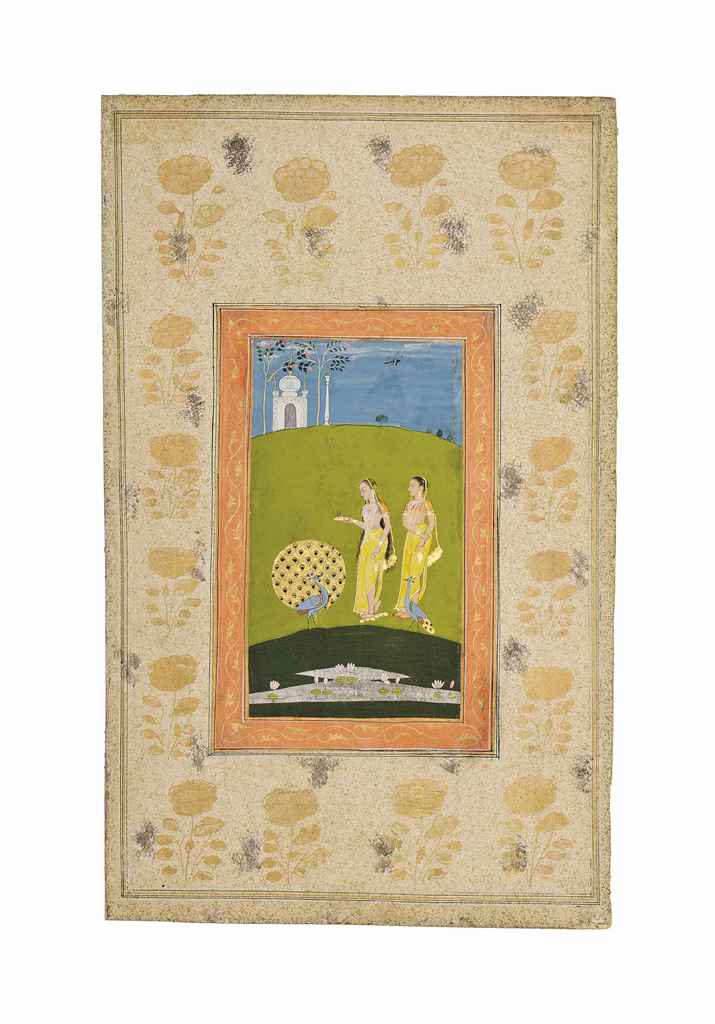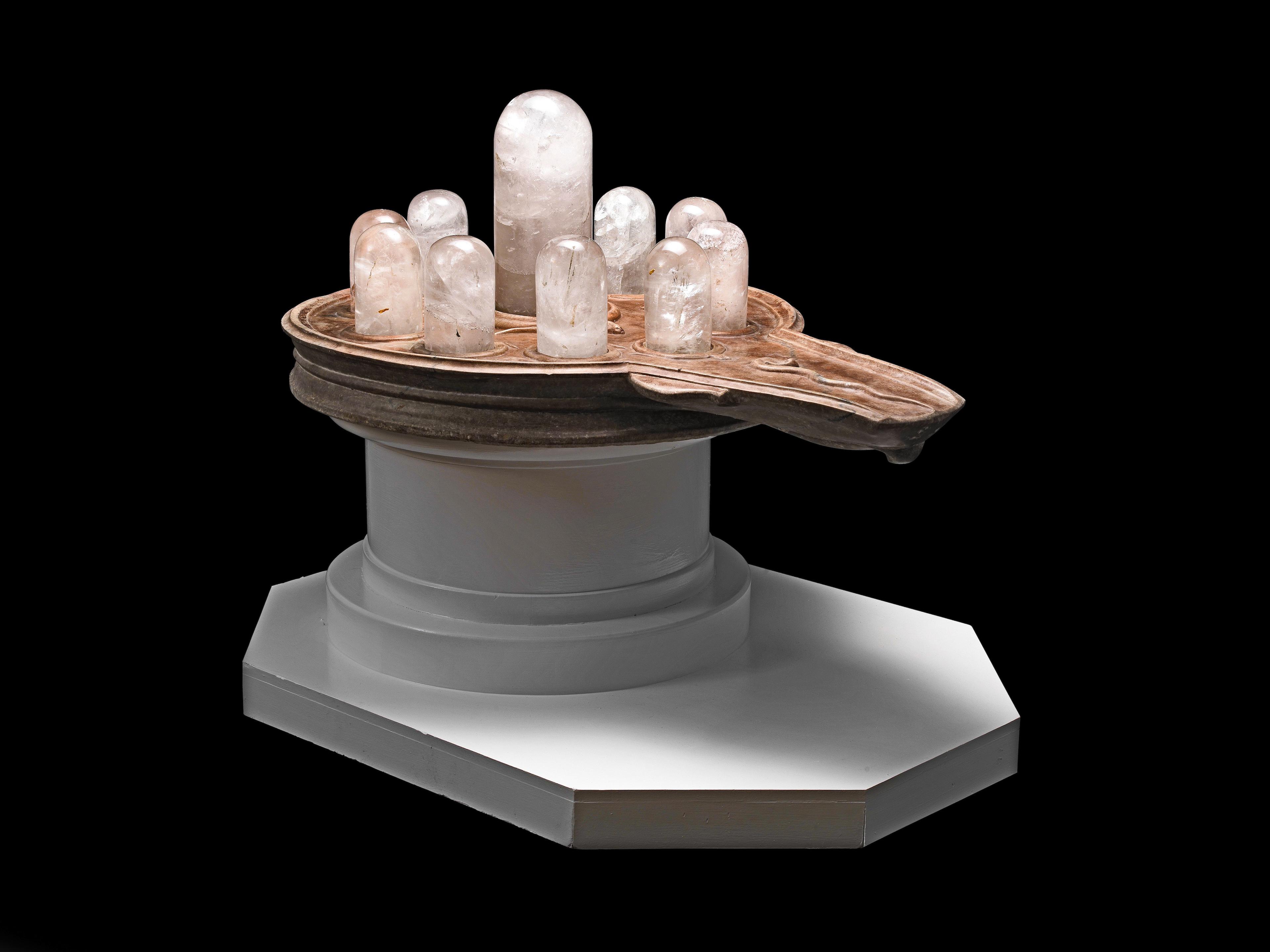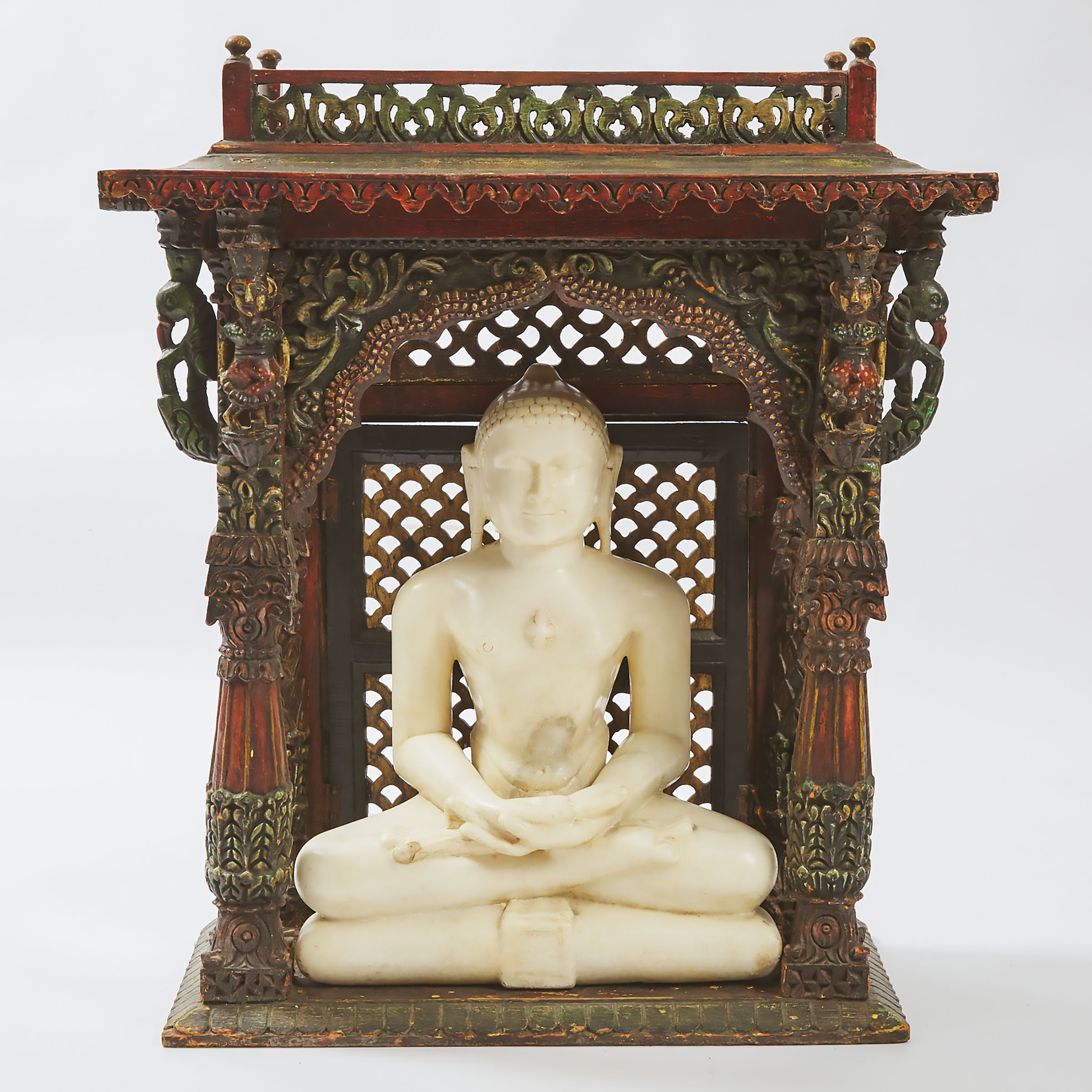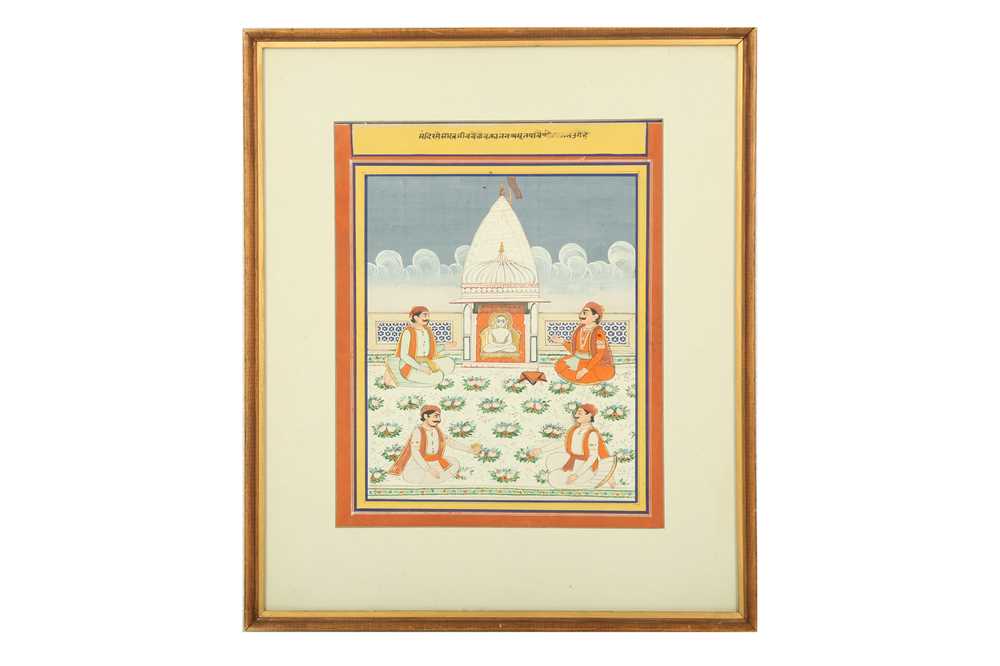DescriptionProperty from an English Private CollectionA Marble Shrine with Relief Decoration
attributed to Giovanni Battista Piranesi (1720-1778)with quadrangular base adorned with a ram's head at each corner and scrolling acanthus along the concave sides; the shrine itself in the form of a funerary altar carved on one side with an arched shallow recess engraved with a quote from Cicero reading Honos est praemium virtutis ("Honour is the reward of virtue"), and on the other with a deep curved recess fitted for display of a bust or statuette, both niches flanked by two tapering Corinthian colonnettes each supporting a delicate tripod; one short side of the altar ornamented with a couchant ram(?) beneath a hanging set of Pan pipes against crossed horns, the other with a wreathed lyre above a coiled serpent; the cornice with multiple mouldings supporting two rotuli linked by volutes centring a palmette, a shallow recess on top.124.5 by 76.5 and 63.5 cm.Condition reportThe plain base and leaf moulding are each carved separately from the top unit, which includes the ram-headed base and the shrine. On one side, the front of one of the ram's head and one entire head were carved separately or restored. The volutes underneath each of the four heads were also carved separately. One is missing. As described in the catalogue note, the shrine was shortened at some point, requiring restorations (now lost) to the edges including the bottom of the columns. The top and bottom of the shrine are now separate and can be reassembled by means of iron pins. A hairline crack around the bottom part of the shrine was strengthened using two (now corroded) metal clamps sunk into deep vertical channels, one on each side of the shrine. Minor chips, areas of abrasions, and vegetal growth overall.
Please note that Condition 12 of the Conditions of Business for Buyers (Online Only) is not applicable to this lot.
The lot is sold in the condition it is in at the time of sale. The condition report is provided to assist you with assessing the condition of the lot and is for guidance only. Any reference to condition in the condition report for the lot does not amount to a full description of condition. The images of the lot form part of the condition report for the lot. Certain images of the lot provided online may not accurately reflect the actual condition of the lot. In particular, the online images may represent colors and shades which are different to the lot's actual color and shades. The condition report for the lot may make reference to particular imperfections of the lot but you should note that the lot may have other faults not expressly referred to in the condition report for the lot or shown in the online images of the lot. The condition report may not refer to all faults, restoration, alteration or adaptation. The condition report is a statement of opinion only. For that reason, the condition report is not an alternative to taking your own professional advice regarding the condition of the lot. NOTWITHSTANDING THIS ONLINE CONDITION REPORT OR ANY DISCUSSIONS CONCERNING A LOT, ALL LOTS ARE OFFERED AND SOLD "AS IS" IN ACCORDANCE WITH THE CONDITIONS OF SALE/BUSINESS APPLICABLE TO THE RESPECTIVE SALE.ProvenanceGiovanni Battista Piranesi (1720-1778), RomeWilliam Ponsonby, 2nd Earl of Bessborough (1704-1793), Parkstead House, Roehampton, Middlesex, probably acquired through his agent Thomas Jenkinsby descent to John Ponsonby, 5th Earl of Bessborough (1809-1880) (probably Christie's, July 10th-11th, 1850)William Lowther, 2nd Earl of Lonsdale (1787-1872), Lowther Castle, Penrith, Cumberland, probably acquired at the above salethen by descent to Lancelot Lowther, 6th Earl of Lonsdale (1867-1953), Lowther Castle (probably Maple & Co., Ltd., and Thomas Wyatt Penrith, Lowther Castle, near Penrith, Cumberland. The Major Part of the Earl of Lonsdale's Collection, April 29th-May 1st, 1947)English private collection, acquired in the late 1940s/1950sby descent to the present owner
Published:Llewellynn Jewitt and S. C. Hall, The Stately Homes of England, vol. 2, London, 1877, p. 310: "a monument from the Besborough [sic] collection, inscribed "Honos est praemium virtutis"(https://books.google.com/books?id=e5FjB5v0wbAC&lpg=PA310&ots=JOWHHbpV5H&dq)Felice Stampfle, Giovanni Battista Piranesi Drawings in the Pierpont Morgan Library, New York, 1978, no. 38, illus. (https://www.themorgan.org/drawings/item/142417)
This elaborate antiquarian creation, which probably served as a shrine for an actual antiquity, is documented in a drawing by Piranesi's own hand. Two of its decorative motifs, the lyre and pan pipes, are stylistically highly reminiscent of similar elements carved on monumental relief panels designed by Piranesi for the wall opposite Santa Maria del Priorato, the Church of the Knights of Malta in Rome (https://www.themorgan.org/drawings/item/142428, https://www.alamy.com/stock-photo-piazza-dei-cavalieri-di-malta-aventine-hill-rome-italy-18599841.html).
In typical Piranesi fashion, the four-sided base with ram's head in the corners is inspired by the top section of a three-sided Roman candelabrum base (e.g. https://www.britishmuseum.org/collection/object/G_2010-5006-1862).Originally, the altar feature of the present monument was carved taller than it is now, probably matching the proportions of Piranesi's sketch. A narrow section was removed from the middle, causing the edges of three of the tapering column shafts to no longer fit together. This necessitated the removal of part of the upper section of each shaft and the insertion of a newly carved connecting insert. All three of these inserts are now missing.Catalogue noteThis elaborate antiquarian creation, which probably served as a shrine for an actual antiquity, is documented in a drawing by Piranesi's own hand. Two of its decorative motifs, the lyre and pan pipes, are stylistically highly reminiscent of similar elements carved on monumental relief panels designed by Piranesi for the wall opposite Santa Maria del Priorato, the Church of the Knights of Malta in Rome (https://www.themorgan.org/drawings/item/142428, https://www.alamy.com/stock-photo-piazza-dei-cavalieri-di-malta-aventine-hill-rome-italy-18599841.html).
In typical Piranesi fashion, the four-sided base with ram's head in the corners is inspired by the top section of a three-sided Roman candelabrum base (e.g. https://www.britishmuseum.org/collection/object/G_2010-5006-1862).
Originally, the altar feature of the present monument was carved taller than it is now, probably matching the proportions of Piranesi's sketch. A narrow section was removed from the middle, causing the edges of all four tapering column shafts to no longer fit together. This necessitated the removal of the upper section of each shaft and the insertion of a newly carved connecting insert. All four of these inserts are now missing.
DescriptionProperty from an English Private CollectionA Marble Shrine with Relief Decoration
attributed to Giovanni Battista Piranesi (1720-1778)with quadrangular base adorned with a ram's head at each corner and scrolling acanthus along the concave sides; the shrine itself in the form of a funerary altar carved on one side with an arched shallow recess engraved with a quote from Cicero reading Honos est praemium virtutis ("Honour is the reward of virtue"), and on the other with a deep curved recess fitted for display of a bust or statuette, both niches flanked by two tapering Corinthian colonnettes each supporting a delicate tripod; one short side of the altar ornamented with a couchant ram(?) beneath a hanging set of Pan pipes against crossed horns, the other with a wreathed lyre above a coiled serpent; the cornice with multiple mouldings supporting two rotuli linked by volutes centring a palmette, a shallow recess on top.124.5 by 76.5 and 63.5 cm.Condition reportThe plain base and leaf moulding are each carved separately from the top unit, which includes the ram-headed base and the shrine. On one side, the front of one of the ram's head and one entire head were carved separately or restored. The volutes underneath each of the four heads were also carved separately. One is missing. As described in the catalogue note, the shrine was shortened at some point, requiring restorations (now lost) to the edges including the bottom of the columns. The top and bottom of the shrine are now separate and can be reassembled by means of iron pins. A hairline crack around the bottom part of the shrine was strengthened using two (now corroded) metal clamps sunk into deep vertical channels, one on each side of the shrine. Minor chips, areas of abrasions, and vegetal growth overall.
Please note that Condition 12 of the Conditions of Business for Buyers (Online Only) is not applicable to this lot.
The lot is sold in the condition it is in at the time of sale. The condition report is provided to assist you with assessing the condition of the lot and is for guidance only. Any reference to condition in the condition report for the lot does not amount to a full description of condition. The images of the lot form part of the condition report for the lot. Certain images of the lot provided online may not accurately reflect the actual condition of the lot. In particular, the online images may represent colors and shades which are different to the lot's actual color and shades. The condition report for the lot may make reference to particular imperfections of the lot but you should note that the lot may have other faults not expressly referred to in the condition report for the lot or shown in the online images of the lot. The condition report may not refer to all faults, restoration, alteration or adaptation. The condition report is a statement of opinion only. For that reason, the condition report is not an alternative to taking your own professional advice regarding the condition of the lot. NOTWITHSTANDING THIS ONLINE CONDITION REPORT OR ANY DISCUSSIONS CONCERNING A LOT, ALL LOTS ARE OFFERED AND SOLD "AS IS" IN ACCORDANCE WITH THE CONDITIONS OF SALE/BUSINESS APPLICABLE TO THE RESPECTIVE SALE.ProvenanceGiovanni Battista Piranesi (1720-1778), RomeWilliam Ponsonby, 2nd Earl of Bessborough (1704-1793), Parkstead House, Roehampton, Middlesex, probably acquired through his agent Thomas Jenkinsby descent to John Ponsonby, 5th Earl of Bessborough (1809-1880) (probably Christie's, July 10th-11th, 1850)William Lowther, 2nd Earl of Lonsdale (1787-1872), Lowther Castle, Penrith, Cumberland, probably acquired at the above salethen by descent to Lancelot Lowther, 6th Earl of Lonsdale (1867-1953), Lowther Castle (probably Maple & Co., Ltd., and Thomas Wyatt Penrith, Lowther Castle, near Penrith, Cumberland. The Major Part of the Earl of Lonsdale's Collection, April 29th-May 1st, 1947)English private collection, acquired in the late 1940s/1950sby descent to the present owner
Published:Llewellynn Jewitt and S. C. Hall, The Stately Homes of England, vol. 2, London, 1877, p. 310: "a monument from the Besborough [sic] collection, inscribed "Honos est praemium virtutis"(https://books.google.com/books?id=e5FjB5v0wbAC&lpg=PA310&ots=JOWHHbpV5H&dq)Felice Stampfle, Giovanni Battista Piranesi Drawings in the Pierpont Morgan Library, New York, 1978, no. 38, illus. (https://www.themorgan.org/drawings/item/142417)
This elaborate antiquarian creation, which probably served as a shrine for an actual antiquity, is documented in a drawing by Piranesi's own hand. Two of its decorative motifs, the lyre and pan pipes, are stylistically highly reminiscent of similar elements carved on monumental relief panels designed by Piranesi for the wall opposite Santa Maria del Priorato, the Church of the Knights of Malta in Rome (https://www.themorgan.org/drawings/item/142428, https://www.alamy.com/stock-photo-piazza-dei-cavalieri-di-malta-aventine-hill-rome-italy-18599841.html).
In typical Piranesi fashion, the four-sided base with ram's head in the corners is inspired by the top section of a three-sided Roman candelabrum base (e.g. https://www.britishmuseum.org/collection/object/G_2010-5006-1862).Originally, the altar feature of the present monument was carved taller than it is now, probably matching the proportions of Piranesi's sketch. A narrow section was removed from the middle, causing the edges of three of the tapering column shafts to no longer fit together. This necessitated the removal of part of the upper section of each shaft and the insertion of a newly carved connecting insert. All three of these inserts are now missing.Catalogue noteThis elaborate antiquarian creation, which probably served as a shrine for an actual antiquity, is documented in a drawing by Piranesi's own hand. Two of its decorative motifs, the lyre and pan pipes, are stylistically highly reminiscent of similar elements carved on monumental relief panels designed by Piranesi for the wall opposite Santa Maria del Priorato, the Church of the Knights of Malta in Rome (https://www.themorgan.org/drawings/item/142428, https://www.alamy.com/stock-photo-piazza-dei-cavalieri-di-malta-aventine-hill-rome-italy-18599841.html).
In typical Piranesi fashion, the four-sided base with ram's head in the corners is inspired by the top section of a three-sided Roman candelabrum base (e.g. https://www.britishmuseum.org/collection/object/G_2010-5006-1862).
Originally, the altar feature of the present monument was carved taller than it is now, probably matching the proportions of Piranesi's sketch. A narrow section was removed from the middle, causing the edges of all four tapering column shafts to no longer fit together. This necessitated the removal of the upper section of each shaft and the insertion of a newly carved connecting insert. All four of these inserts are now missing.





.jpg)








Try LotSearch and its premium features for 7 days - without any costs!
Be notified automatically about new items in upcoming auctions.
Create an alert